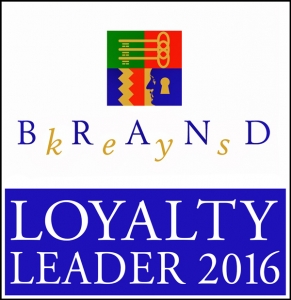
More than a third (35%) of the 2016 Brand Keys Loyalty Leaders are represented by digital technology, social networking brands, or brands that facilitate digital tech or social networking. That was one of the key findings in the 20th annual Loyalty Leaders survey. And while digital brands not only represent the lion’s share of this year’s list, they also command 80% of the top 20 loyalty leaders spots as well.
Loyalty Is a Gift and a Curse
Consumers haven’t entirely deserted traditional brands. The largest loyalty shifts this year have been in more traditional areas like apparel retail and athletic footwear, which for brands turns out to be both a gift and a curse.
Gift-wise loyalty is a leading-indicator of positive consumer behavior toward brands. Oh, and loyal consumers are six times more likely to behave better toward that brand.
The “Curse” aspect means it’s getting more difficult for non-digital brands to create the kind of emotional engagement consumers desire – for connection and distinction, tailored to ever-increasing consumer expectations regarding customization of products, services, and experiences. This environment forces brands to work harder to create emotional engagement. Want to know what consumers are going to do? Measure loyalty and emotional engagement.
2016 Top 20 Brand Keys Loyalty Leaders:
(Numbers in parentheses indicate last year’s brand ranking)
- Google: search engines (#6)
- Amazon: online retail (#8)
- Apple: tablets (#4)
- Netflix: video streaming (#1)
- Facebook: social networking (#5)
- Apple: Smartphones (#3)
- Amazon: tablets (#2)
- YouTube: social networking (#7)
- Amazon: video streaming (#10)
- WhatsApp: instant messaging (#9)
- iTunes: video streaming (#13)
- PayPal: online payments (#18)
- Dunkin’ Donuts: coffee (#17)
- Samsung: smartphones (#11)
- Nike: athletic footwear (#31)
- Ford: automotive (#22)
- Uber: app-based rideshare (#21)
- Starbucks: coffee (#40)
- LinkedIn: social networking (#16)
- Zappos: online retail (#12)
Loyalty’s Rule of Six
The kind of loyalty generated by leader brands means consumers are six times more likely to use the brand’s products and services in other categories too, which makes it harder for others to break into the top 100, let alone the top 20. This year Brand Keys examined 635 brands in 72 categories. To compound the challenge of rising to, say, the top 20, a number of brands ended up bein represented in multiple categories, like Amazon (which appears in the top 20 in three categories: Online Retail, Tablets, and Video Streaming). Google, which moved up five spots to rank #1 this year and was represented in both Search and Online Payments and Apple, which was rated highly in the Tablets, Smartphones, and Video Streaming categories.
Category Loyalty Leaders. Digital and. . .
Digital technology and social networking brands had the most Loyalty Leader brands, and represented 35% of the 2016 list. Other categories represented by Loyalty Leader brands included:
- Retail: 17%
- Beverages: 9%
- Automotive: 8%
- Cosmetics: 8%
- Financial: 6%
- Restaurants: 6%
- Travel: 4%
Nine New Brands Replace Nine Old Brands
Nine of the top 100 Brand Keys Loyalty Leaders are new: 4 digital: Airbnb (#52), Line (#72), theSkimm (#76) and BuzzFeed (#95), with the remaining 5 including: Häagen-Dazs (#85), Jack Daniels (#92), Burt’s Bees (#96), Lowe’s (#99), and Vanguard (#100).
Brands that slipped from the top 100 included all hotel brands that had made last year’s list: Ritz-Carlton, W Hotels, Hyatt, and Hilton, a partial explanation of Airbnb’s spectacular first showing. Other brands that fell from this year’s top 100 include Neutrogena, Revlon, Macy’s, FIFA, and HTC Smartphones.
2016’s Biggest Loyalty Winners
Loyalty and emotional engagement are leading-indicators of consumer behavior toward a brand. That equation looks like this:
Loyalty + Emotional Engagement = Positive Consumer Behavior = $$$$
Axiomatically, the better consumers behave toward a brand, the better the brand does in the marketplace, which ultimately shows up on brands’ bottom lines. The 7 brands (including ties) that showed the greatest loyalty leadership gains were:
- Starbuck’s (+22 to #18)
- Ralph Lauren (+19 to #24)
- Nike (+16 to #15)
- LG (+15 to #31)
- Domino’s (+15 to #43)
- HBO GO (+15 to #63)
- Under Armour (+13 to #28)
The Biggest Loyalty Losers
The 5 brands with the greatest loyalty erosion included
- Chipotle (-45 to #68)
- Estee Lauder (-34 to #87)
- eBay (-26 to #64)
- Clinique (-21 to #97)
- GAP (-20 to #93)
The bottom line? No matter the category, brands that understand that emotional connections serve as surrogates for added value, have succeeded. And brands that have made loyalty and emotional engagement a strategic priority always appear high on the Loyalty Leaders List, and always appear at the top of consumers’ shopping lists.
Methodology
Brand Keys Loyalty Leaders analysis was conducted in September 2016 and includes assessments from 42,792 consumers, 18 to 65 years of age, from the nine US Census Regions, who self-selected the categories in which they are consumers and the brands for which they are customers. Seventy-five percent (75%) were interviewed by phone, 20% via face-to-face interviews (to account for cell phone-only consumers), and remaining consumers assessed categories and brands online. The 2016 Loyalty Leader assessments examined 72 categories and 635 brands.
Unlike economic use models, which rely heavily on historical data and profitability conjecture, the Brand Keys Loyalty and Engagement Model and rankings are 100% consumer-driven, and are predictive, leading-indicators of brand and corporate profitability. The good news is that brand loyalty is understandable. The better news is, it can be quantified and predicted. And, today, knowing what’s coming down the road from a category and competitive perspective is an extraordinarily powerful advantage that brands shouldn’t really pass up.”
The complete top-100 2016 Loyalty Leaders List, is available here.
Find out more about what makes customer loyalty happen and how Brand Keys metrics is able to predict future consumer behavior: brandkeys.com. Visit our YouTube channel to learn more about Brand Keys methodology, applications and case studies.
Share this: